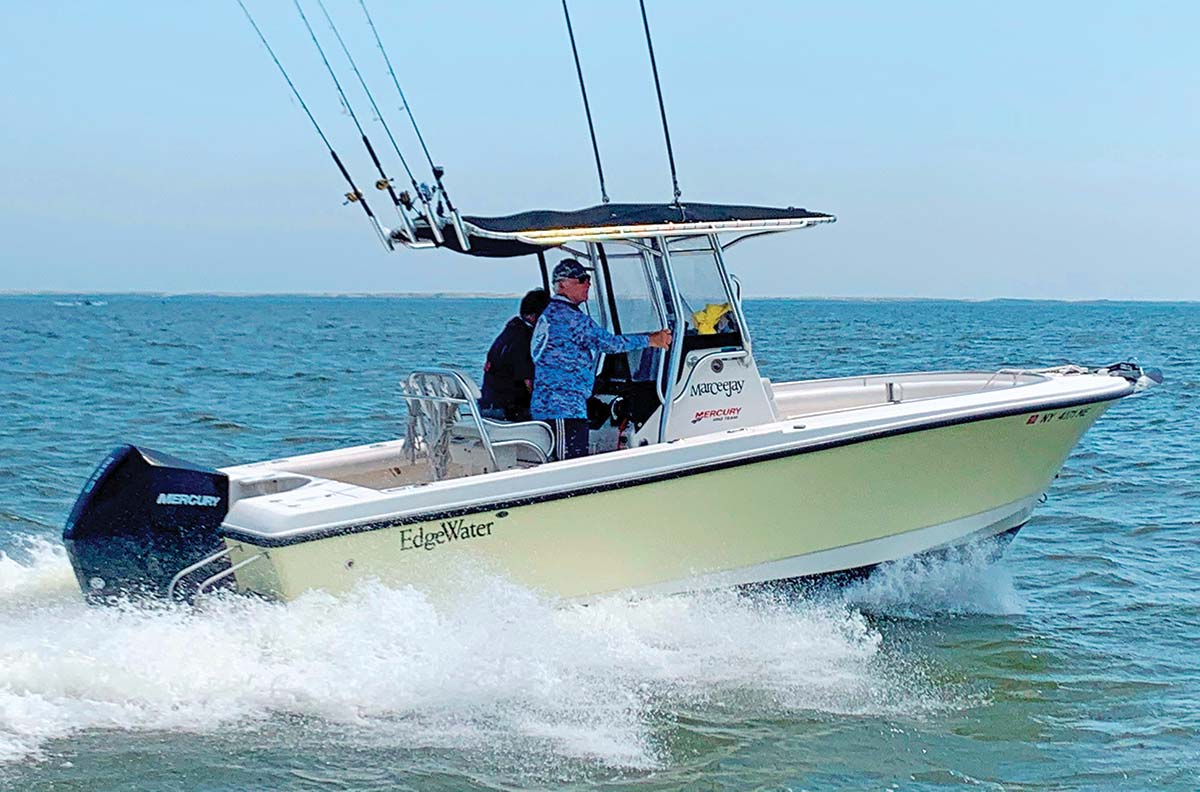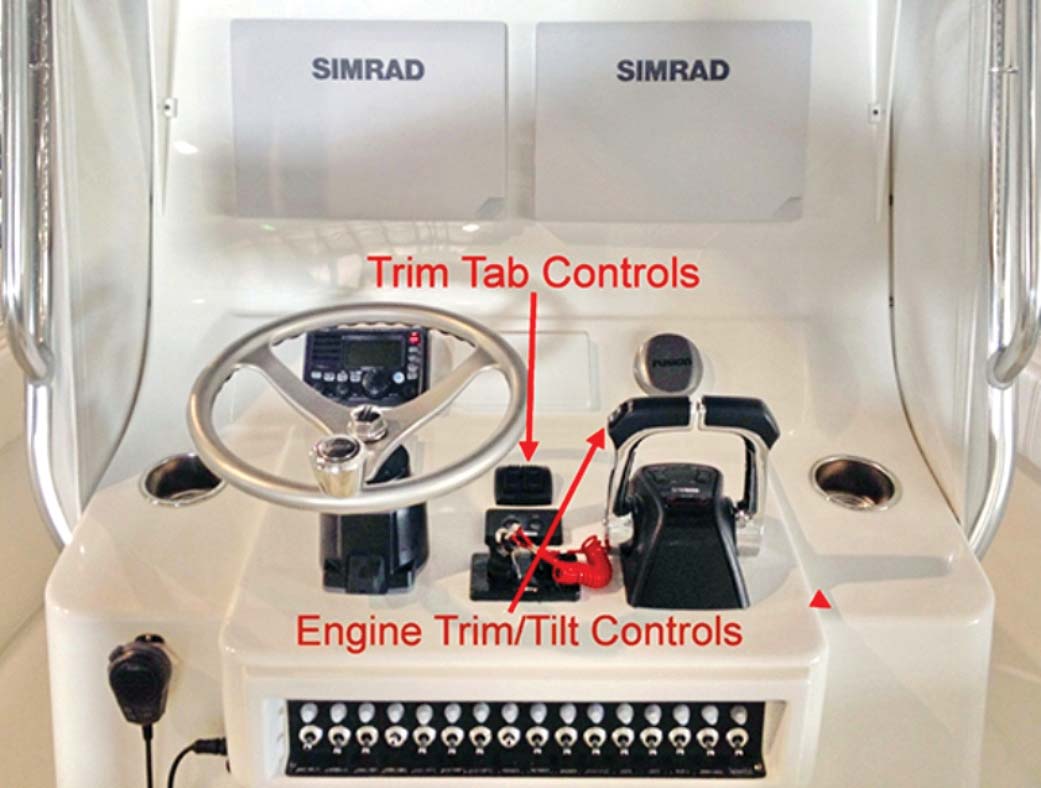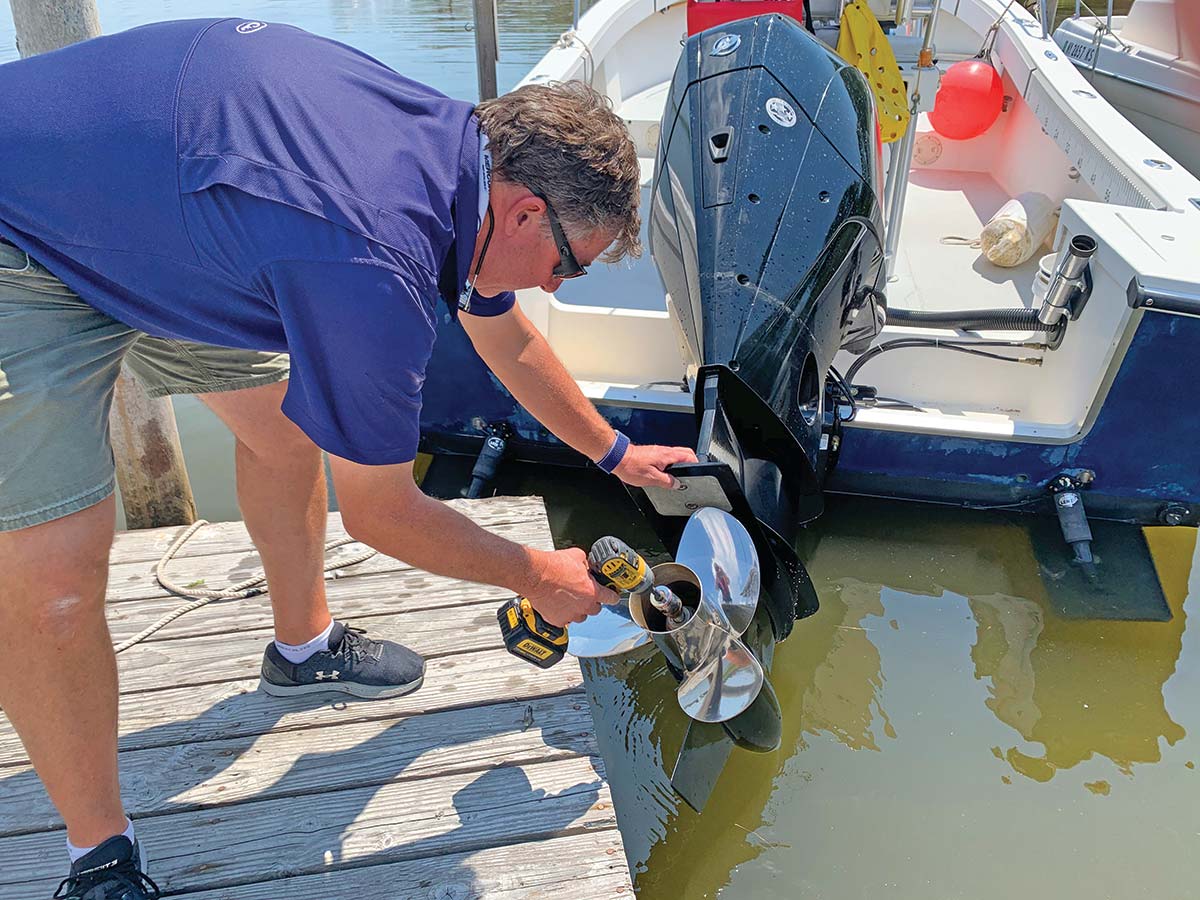
To paraphrase Clint Eastwood’s Dirty Harry, boaters “got to know their limitations.”
Understanding how and why your boat performs in different scenarios goes a long way to ensuring both your fun and safety out on the fishing grounds. It’s important to take into account that wind, waves, current, weight, boat loading, crew size, engine mechanical status, fuel quality, running bottom condition, trim attitude, among other variables, all collaborate to impact your ride. Ignoring just one of these factors can totally ruin your day.
Before you can begin to ascertain the nuances of maximizing your vessel’s range and performance, you must first know the platform that’s floating under your deck shoes; what’s the maximum horsepower capacity for your boat; what’s the actual size of your fuel tank (not the catalog spec); what about displacement with engines, fuel, water and all of your gear onboard; and how about maximum weight and passenger capacities? Knowing the answers to these questions will get you started in the right direction when attempting to determine your range and top speeds.
Since how far you can travel is a direct function of how fast you are going and for how long – all while consuming fuel from a finite source at a variable flow rate – understanding how one action influences another will give you the knowledge that you need to have many successful journeys. It’s a great idea is to pop open the pie hatches positioned over your boat’s fuel tank sender units and fuel pickups for an occasional inspection. One item that you’ll find on the tank, whether it’s plastic or aluminum, is a manufacturer’s label with the construction date and its capacity in gallons. Sometimes the actual tank size might be a few gallons more or less than a boat’s stated catalog spec, so it’s always worth a quick look.
Engine Trim & Tabs
When I head down to the Fort Lauderdale Boat Show later this month, one of the top priorities on my checklist – besides testing new boats and power options – is to speak with the engineering teams to get as much mechanical, design and scientific knowledge as possible. This in turn makes me a better captain when doing home and away charters, in addition to being able to share these tidbits of knowledge with my readership. My PR buds at Yamaha Marine produced an excellent Boaters Log summary document on the topic of engine trim and trim tabs a few years back that is still relevant today, which I will highlight for you.
The more power you apply via the throttle, the more your boat’s hull planes, rising up out of the aqueous medium and reducing the amount of surface that’s in contact with the water. Keeping the boat balanced fore and aft and on an even keel affects how efficiently a boat will run. This is called “trim,” and a properly trimmed hull has a trio of very beneficial results, specifically reduced fuel consumption, increased speed and a more comfortable ride. Most outboard and I/O powered boats have two systems designed specifically to control your vessel’s trim angles…the trim and tilt system that is part of the outboard engine(s) or outdrive(s); and a pair of electric or hydraulic trim tabs that are mounted at the aft transom/hull side corner junctions of the running bottom.
Most outboard engines over 60-horsepower are typically equipped with an electric trim and tilt system that is driven by a hydraulic ram located in the center of the engine mounting bracket. Its function is to raise and lower the engine and it’s controlled by an up/down rocker switch built into the shift/throttle control handle, located directly under your right thumb for ease of operation. For boats with more than one outboard, this switch will usually operate all engines simultaneously.
| PERSONAL PERFORMANCE |
| A few years back by Mercury’s northeast regional field engineer Travis Hayes drew up a pair of performance charts that tell the entire story of why I chose to run a Mercury Racing custom shop Enertia ECO 16.5 diameter by 16 pitch prop on my EdgeWater’s Merc 250 V8 outboard. If you want to determine the best prop type and pitch for your ride, replicating what we did for my boat may bring you to the promised land. I prefer to use “knots” for my speed and nautical miles to determine my distances, since coastal charts are typically set up for those measurements. – Capt. J. Raguso |
In the “tilt” mode, the system raises the engine completely out of the water when not in use. It can also be used to raise the engine when running the boat slowly in very shallow water to prevent skeg or propeller damage. In trim mode, the system works to adjust the angle of the engine to affect the running angle of the boat. As the boat increases speed, the engine angle provides the lift necessary to bring the boat on plane for optimal performance. In the full down position, the engine is in “negative trim,” meaning the angle of the engine shaft and propeller is slightly forward of straight down in relation to the transom. This is the position the engine should be in before throttling up from a dead stop. Negative trim exerts downward force on the hull to reduce bow rise that is common to most planing hulls under initial acceleration. The harder the initial acceleration, the greater the tendency the bow will rise. If you throttle up hard from a dead stop, (a.k.a. hole shot) some hulls will lift the bow at a severe angle momentarily until the downward force of the engine counters the rise.
As the boat picks up speed, the bow will settle in and negative trim will become a hindrance to performance because it will inhibit the hull from getting on plane. Now is the time to raise the engine using the trim switch on the throttle to change the angle from negative to positive trim. To find optimum trim at cruising speeds, raise the engine slowly until you start to feel the hull rise. As it comes on plane, both engine RPM and speed will increase without changing the throttle setting and the steering will feel lighter. These are all effects caused by the hull rising on plane, which reduces the amount of bottom in contact with the water. Less hull contact minimizes hull-to-water friction, producing more speed, with less power and fuel required to push the boat.
The second part of the trim equation is performed by your vessel’s trim tabs. While the trim control on your engine’s throttle handle affects the up and down movement of the bow and how it attacks the waves, the trim tabs impact the side-to-side movement of the hull to help you keep it on an even keel, with the optimum travel position being bow slightly up and chines level. Trim tabs are independently operated, adjustable hinged metal after-planes attached to the bottom edge of your vessel’s transom corners. When the tab’s helm control is pressed, this moves the actuating cylinders to deflect the trim tabs either downward or upward via mechanical or hydraulic pressure, redirecting water flow at the transom corners.
When a tab is moved downwards, the water flow creates an upward pressure under the plane, raising that corner of the stern. As the stern rises, the bow on the opposite side is lowered. This opposing or “crossed-X” effect is a normal trim tab operating procedure. The starboard control button controls the port trim tab, which lifts or lowers the port stern corner, subsequently moving the starboard bow in the opposite direction. Conversely, the port tab button controls the angle of the starboard trim tab, causing the pressure of redirected water flow at the starboard transom corner to impact the attitude of the port bow in a similar manner. The operation of the helm control is usually based on the direction you wish to move the bow (port/starboard bow up; port/starboard bow down). Simply press the control buttons, rocker switch or joystick in the preferred direction of the indicator arrows to keep your boat on an even keel.

Achieving Optimum RPM
Four-stroke engine manufacturers provide an operating range for their engines, whether they are inboard or outboard. Let’s take my EdgeWater 228 CC’s relatively new Mercury 250-horsepower V8 as an example. The stated operating range for this outboard is 5,200 to 6,000 rpm. Once I’m good to go with people, fuel, bait, ice and gear, my engine will be running in the correct load range with the prop that I am spinning if my max rpms at wide-open-throttle (WOT) trimmed out fall somewhere in this power band.
Experience has taught me that the boat/motor/prop relationship is optimized if you can get the max rpm number somewhere in the middle of the recommended range, which in my case is 5,600 revolutions. This setting typically gives you the best mid-speed acceleration, hole shots, cruising speeds and fuel efficiency throughout the cruising range. When tweaking props and rpms for your ride, the rule of thumb that has been applied for decades by propulsion engineers in this regard is that for every inch of pitch that is either added or subtracted to the propeller, you will decrease (by adding pitch) or increase (by subtracting pitch) engine speed by roughly 200 rpms.
In terms of calculating your vessel’s range, you can typically use only 90 to 95% of the tank’s stated capacity in real world operations. This is due to where the pickups are located, how the internal tank baffles trap puddles of fuel when capacity is getting low and how existing sea conditions impact the flow of fluids sloshing around in the tank. To effectively calculate your boat’s range, you first need to determine how much fuel she burns at various engine rpms and the speed that you achieve at each of the typical benchmark levels, which are usually in 500-rpm increments (3,000, 3,500, 4,000, 4,500, etc.). Once you can fill in the blanks of the typical performance spreadsheet, you’ll learn a lot about how your boat operates, along with the best sweet spots for maxing out speed and range.
The basic math when calculating miles per gallon (mpg) is to take your speed at a given rpm and divide it by your fuel consumption. For example, if your vessel is doing 24 mph while consuming 8 gallons per hour (gph), the 24/8 equation equals 3 mpg. Fuel consumption numbers are usually provided somewhere in your engine’s digital gauge package, which then makes it easy to ascertain your final mpg stats. If you are still running analog gauges on your vessel, employing an old school FlowScan setup will give you a precise picture of how much fuel you are consuming across the rpm band. Once you have created a performance chart with rpms, speeds and mpgs at the various benchmarks, the theoretical range calculation is easy to ascertain. Simply take the fuel tank capacity, subtract 10% of that as a safety reserve and divide the best mpg level into that total.
Here’s an example for a boat that gets 3 mpg at 4,000 rpm and has a 100-gallon fuel tank:
100 gallons x .9 = 90 gallons
90 gallons x 3.0 mpg = 270-mile range

Bay vs. Ocean travel
One of the nuances that I’ve discovered in my decades of bay and ocean travel is that the speed and range factors that I chart in the spreadsheet that I create for each of my vessels is usually conducted in relatively calm bay waters. I’ll factor in wind and tide influences by averaging north/south or east/west runs to average things out, but as soon as I break the inlet and head offshore, things change. The effects of the big water, waves, currents and dynamic ocean environment do a lot to slow things down, translating to less speed for the usual fuel burn, which in turn reduces overall range.
As an example, if my boat gets 2.25 mpg (22.5 knots at 4,000 rpm consuming 10 gph) when traversing the bay, these numbers will typically be lower out in the ocean (more like 20 knots at 4,000 rpm drinking 10 gph). The bottom line is that my ocean range is reduced in the real world, which impacts how far I can travel on any given day. When the wind or weather creates the added conflict of rough seas, speed and mpg numbers are reduced even more, along with usable range.
To factor these dynamics into my theoretical range calculations and safe roundtrip distance limits, I’ll reduce my usable fuel capacity by another 5%, bringing it down to 85% of the total. Taking my EdgeWater 228 CC’s onboard 124-gallon fuel tank as an example and assuming that I have a totally full tank, here’s the math when I am calculating my ocean transit range and its effect on my bay performance numbers:
124-gallon tank x .85 = 105.4 gallons
Optimum cruising speed of 26 knots @ 4,000 rpm = 2.16 nautical mpg
105.4 x 2.16 = 227.7 nautical mile range
If I had a need to go further than that, I could always carry two or three 5-gallon portable polymer gas tanks onboard with an oversized funnel to extend my range somewhat, but this can get both potentially messy and dangerous when performing this refueling operation in rough seas. Fuel bladders are yet another option to extend your range, but these take up valuable space onboard and require custom fuel line setups that can be both expensive and a real pain to operate.
Hopefully some of the science that we have discussed here will give you a better understanding of how to tweak both the performance and range of your ride.



